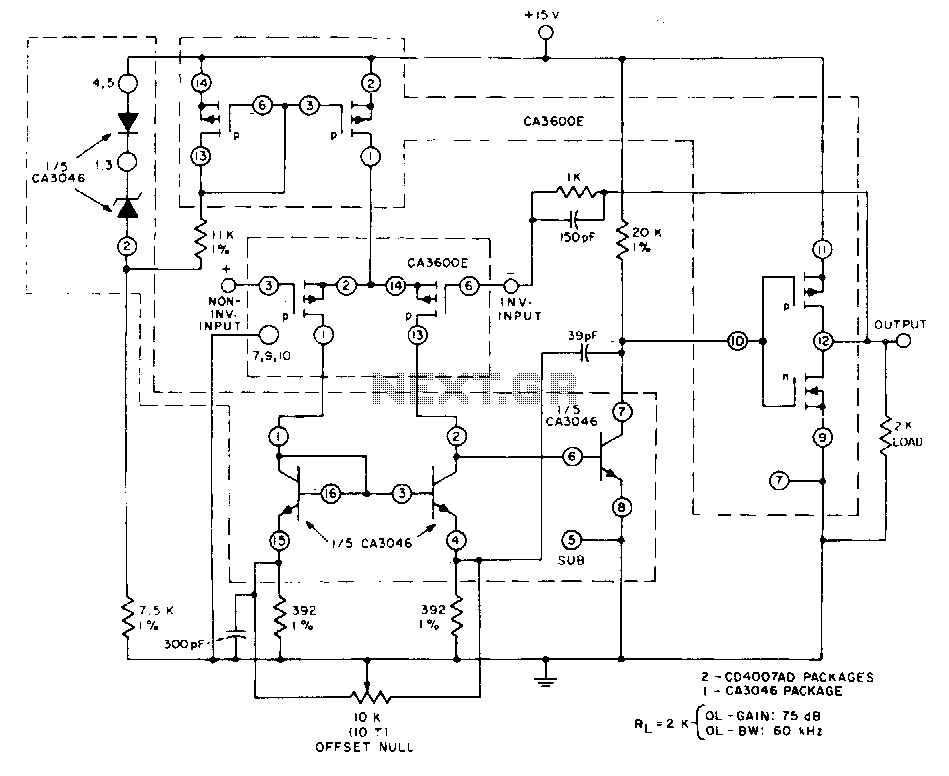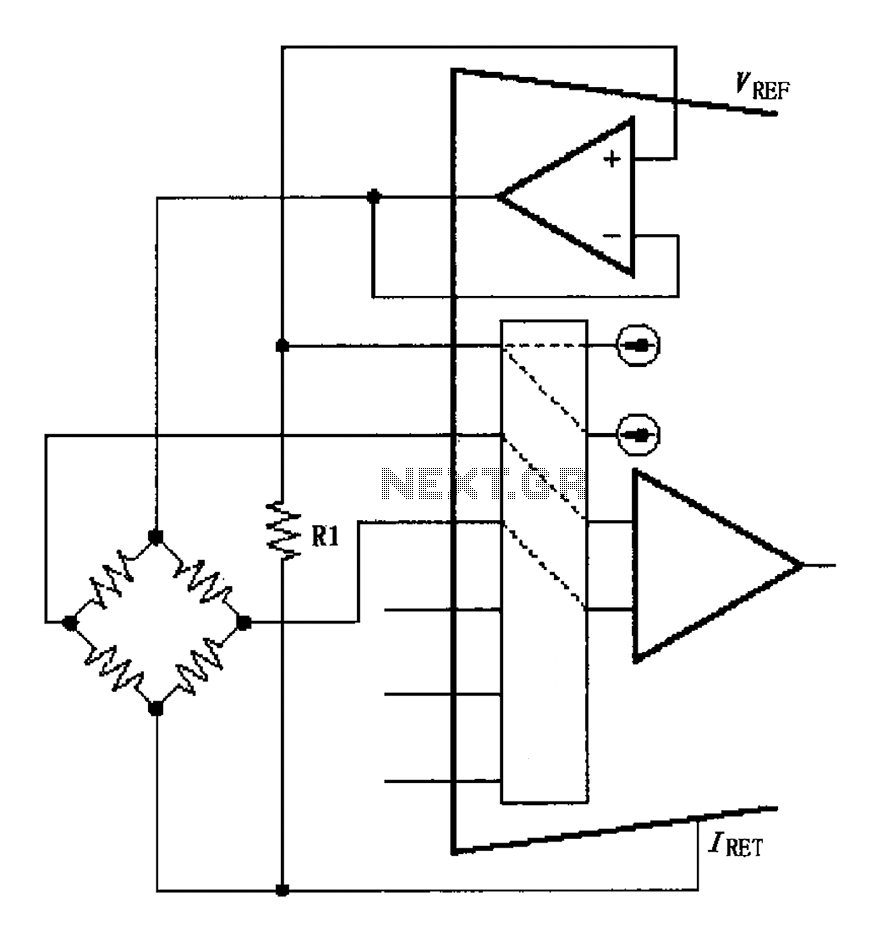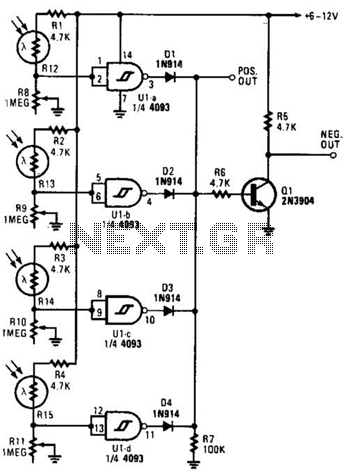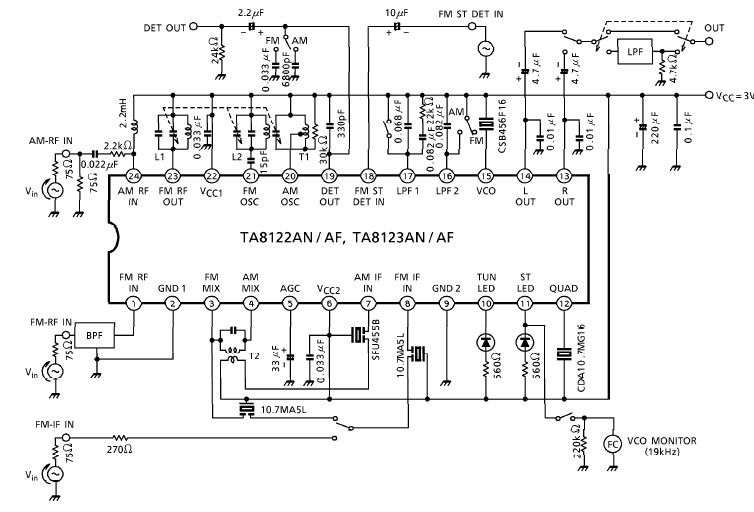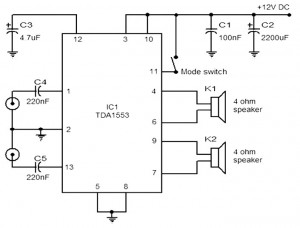
30W amplifier circuit
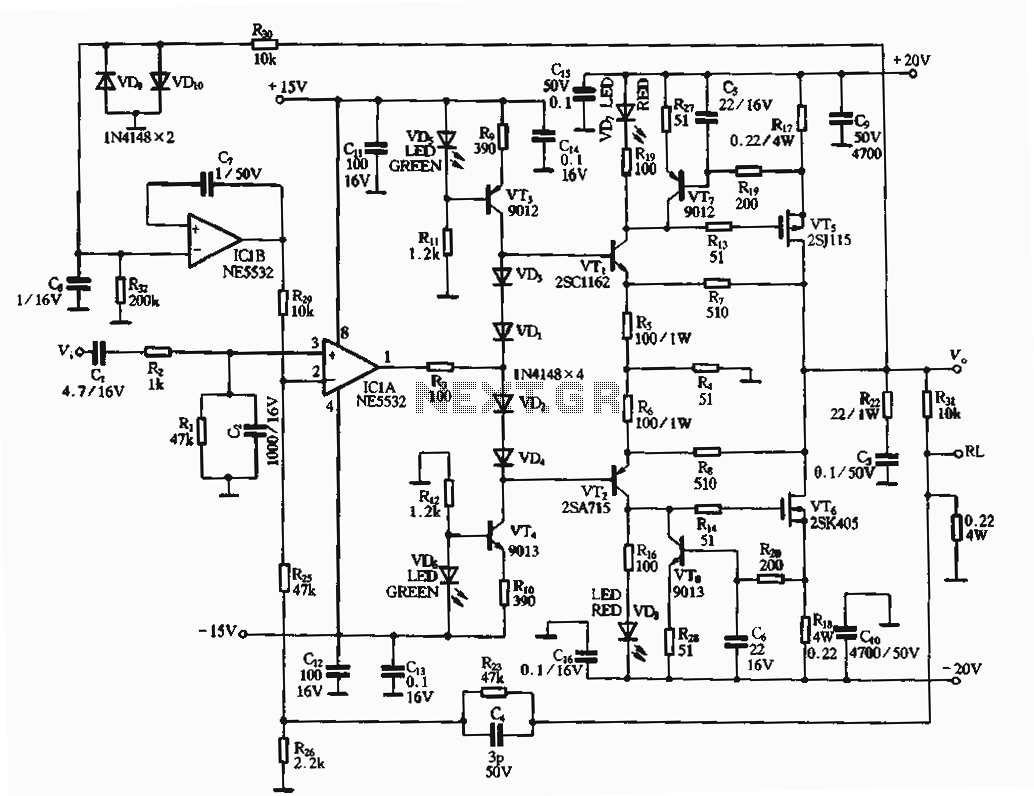
The circuit utilizes an FET amplifier configuration for output, incorporating an NE5532 operational amplifier powered by a 15V supply. The output stage features a FET that amplifies the voltage after passing through several stages. The bias circuit for the output stage is derived from the pre-stage, also operating at 15V, and includes transistors VT3 and VT4. The voltage bias circuit employs two LEDs as voltage references, which not only provide stable electrical characteristics but also indicate the operational status of the circuit. This power supply circuit achieves excellent performance as a constant voltage bias and serves as a pre-stage for a constant current source load, enhancing the gain of the output stage. The push-pull output stage is driven by transistors Vn and VTz, configured in a common emitter arrangement that offers voltage amplification capabilities. The overload protection for the output transistors is managed by VR7 and VTs. The NE5532 operational amplifier also includes a servo circuit. The negative feedback circuit is composed of R23 and C4. The output stage employs VMOS transistors, specifically 2SJ115 and 2SK405, although alternatives such as IRF9130 and IRF130 can also be utilized. Key parameters include a transconductance of 4, a maximum output of 75W at 10V peak-to-peak, and a maximum current of 9A. During testing, the voltage drop across the resistor should be measured at approximately 40 to 50mV with a resistance of 0.22 ohms.
The circuit design features a robust FET amplifier configuration that enhances signal amplification while maintaining stability and reliability. The NE5532 operational amplifier is known for its low noise and high-performance characteristics, making it an ideal choice for audio and precision applications. The use of a dual-voltage power supply derived from the 15V input ensures that both positive and negative voltages are available for the biasing of the output stage, which is critical for optimal amplifier performance.
The incorporation of LEDs as voltage references not only aids in maintaining stable operation but also provides visual feedback on circuit status, which is beneficial during troubleshooting and maintenance. The push-pull configuration of the output stage allows for efficient handling of signal dynamics, reducing distortion and improving linearity.
The overload protection circuit is essential for safeguarding the output transistors from excessive current and thermal stress, ensuring long-term reliability. The feedback loop formed by R23 and C4 is crucial for stabilizing the amplifier's gain and frequency response, thus enhancing overall performance.
Additionally, the choice of VMOS transistors for the output stage is significant due to their high efficiency and fast switching capabilities, making them suitable for high-power applications. The specified parameters, including transconductance and output power, indicate that the circuit is designed to handle substantial loads while providing high fidelity and low distortion.
Overall, this circuit design exemplifies a well-thought-out approach to audio amplification, combining various elements to achieve a high-performance output stage suitable for demanding applications.The circuit is the use of FET amplifier circuit for output. NE5532 op amp using 15V power supply, pushing its output FET output stage after stage voltage amplification. Voltage output stage bias circuit of the input from the pre-stage of 15V, after VT3, VT4 voltage bias circuit to supply. Positive and negative voltage regulator VT3, VT4 uses two LED as a voltage reference, LED not only has good electrical voltage characteristics, and can be used as an indication of the operation of the circuit using this power supply circuit o become not only the excellent performance of constant voltage bias circuit, and it will serve as a pre-stage of the constant current source load, increase the gain of the output stage. Vn, VTz composed of push-pull output stage driven, it is also a common emitter circuit having a voltage amplification capabilities.
Vr7, VTs composition overload protection circuit output tube. ICIb (lf / NE5532) composed 0:00 servo circuit. R23.C4 composition and a negative feedback circuit. VMOS on the tube output stage using 2SJ115 and 2SK405 0 can also be used IRF9130 and IRF130, parameters: transconductance 4, pressure loOvPCM = 75W, Iau = 9A. When debugging, measuring the voltage drop across the resistor is 0.22fl to 40 ~ 50mV.
The circuit design features a robust FET amplifier configuration that enhances signal amplification while maintaining stability and reliability. The NE5532 operational amplifier is known for its low noise and high-performance characteristics, making it an ideal choice for audio and precision applications. The use of a dual-voltage power supply derived from the 15V input ensures that both positive and negative voltages are available for the biasing of the output stage, which is critical for optimal amplifier performance.
The incorporation of LEDs as voltage references not only aids in maintaining stable operation but also provides visual feedback on circuit status, which is beneficial during troubleshooting and maintenance. The push-pull configuration of the output stage allows for efficient handling of signal dynamics, reducing distortion and improving linearity.
The overload protection circuit is essential for safeguarding the output transistors from excessive current and thermal stress, ensuring long-term reliability. The feedback loop formed by R23 and C4 is crucial for stabilizing the amplifier's gain and frequency response, thus enhancing overall performance.
Additionally, the choice of VMOS transistors for the output stage is significant due to their high efficiency and fast switching capabilities, making them suitable for high-power applications. The specified parameters, including transconductance and output power, indicate that the circuit is designed to handle substantial loads while providing high fidelity and low distortion.
Overall, this circuit design exemplifies a well-thought-out approach to audio amplification, combining various elements to achieve a high-performance output stage suitable for demanding applications.The circuit is the use of FET amplifier circuit for output. NE5532 op amp using 15V power supply, pushing its output FET output stage after stage voltage amplification. Voltage output stage bias circuit of the input from the pre-stage of 15V, after VT3, VT4 voltage bias circuit to supply. Positive and negative voltage regulator VT3, VT4 uses two LED as a voltage reference, LED not only has good electrical voltage characteristics, and can be used as an indication of the operation of the circuit using this power supply circuit o become not only the excellent performance of constant voltage bias circuit, and it will serve as a pre-stage of the constant current source load, increase the gain of the output stage. Vn, VTz composed of push-pull output stage driven, it is also a common emitter circuit having a voltage amplification capabilities.
Vr7, VTs composition overload protection circuit output tube. ICIb (lf / NE5532) composed 0:00 servo circuit. R23.C4 composition and a negative feedback circuit. VMOS on the tube output stage using 2SJ115 and 2SK405 0 can also be used IRF9130 and IRF130, parameters: transconductance 4, pressure loOvPCM = 75W, Iau = 9A. When debugging, measuring the voltage drop across the resistor is 0.22fl to 40 ~ 50mV.

